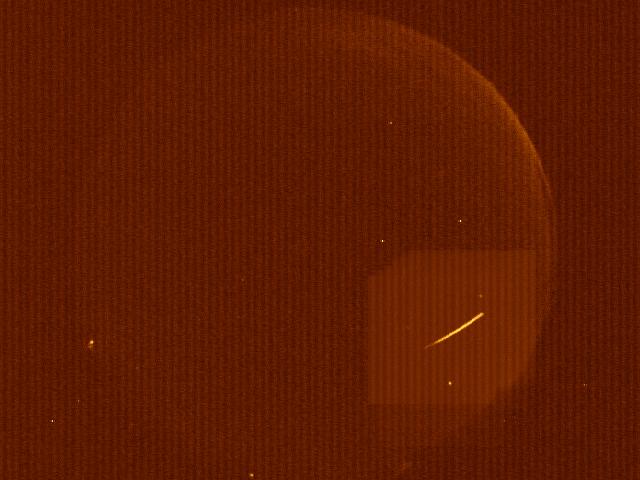
Meteor 1 : April 23, 2008 0250 UT
Observer's Comments: Clear night. Fireball rates higher the past few nights.
Movie 1, Sandia National Laboratories Sentinel camera capture, without sound:
v20080423_0250ut_Ashcraft.mov 912 KB 6 seconds
Movie 2, Ashcraft's video and forward scatter system with sound:
Slow meteor with interesting minimal but obvious reflection.
FB20080423_0250ut_Ashcraft.mp4 1.9 MB 14 seconds
Below: Radio spectrogram of the time of the meteor. 61.250 MHz reception above white line, 83.250 MHz below white line.
Meteor occurs during 0250 UT minute. All other dots and blips on graph are small space dust particles.
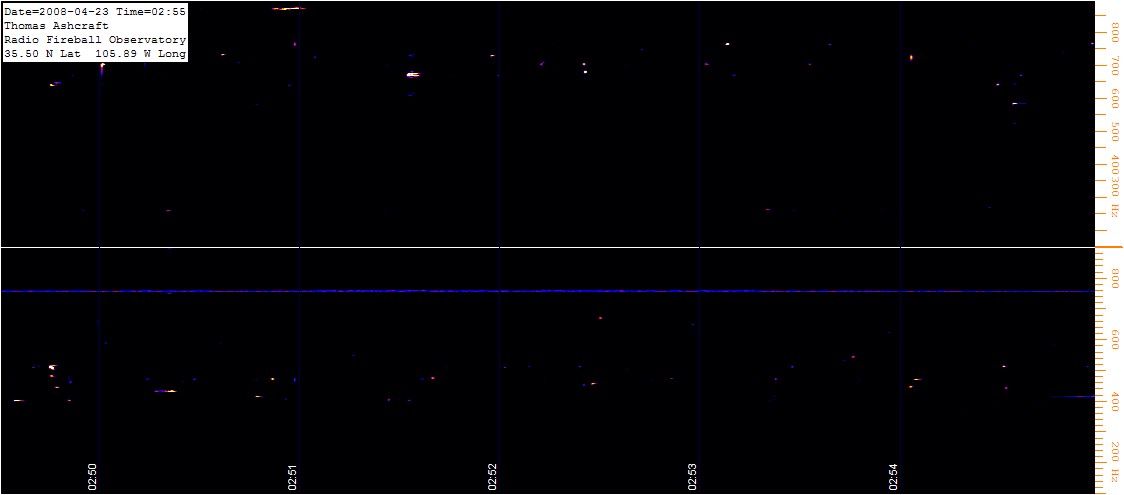
:
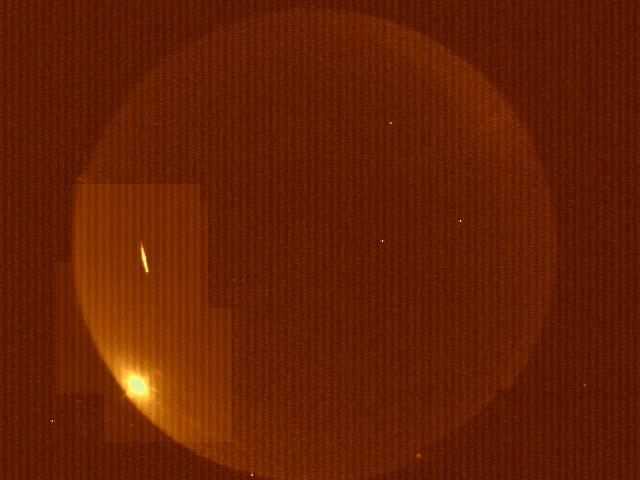
Meteor 2 : April 23, 2008 0525 UT
Observer's Comments: Long radio reflection!
Movies :
Movie 1, Sandia National Laboratories Sentinel camera capture, without sound:
v20080423_0525ut_Ashcraft.mov 881 KB 6 seconds
Movie 2, Ashcraft's video and forward scatter system with sound:
Long and complete to the end radio reflection. LARGE VIDEO FILE!
FB20080423_0525ut_Ashcraft.mp4 14.5 MB 1 minute 58 seconds
Below: Radio spectrogram of the time of the meteor. 61.250 MHz reception above white line, 83.250 MHz below white line.
Meteor occurs during 0523-0525 UT minutes. All other dots and blips on graph are small space dust particles.
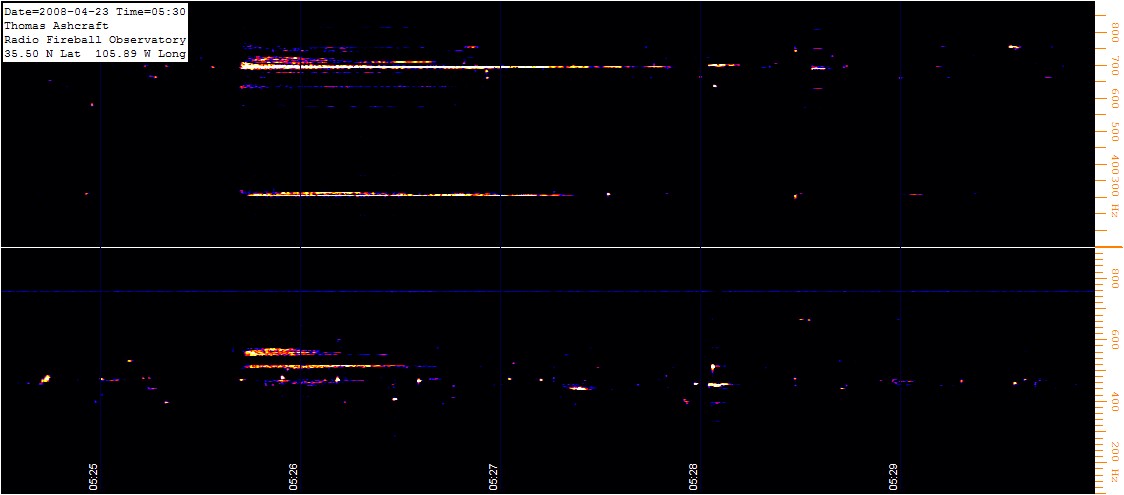
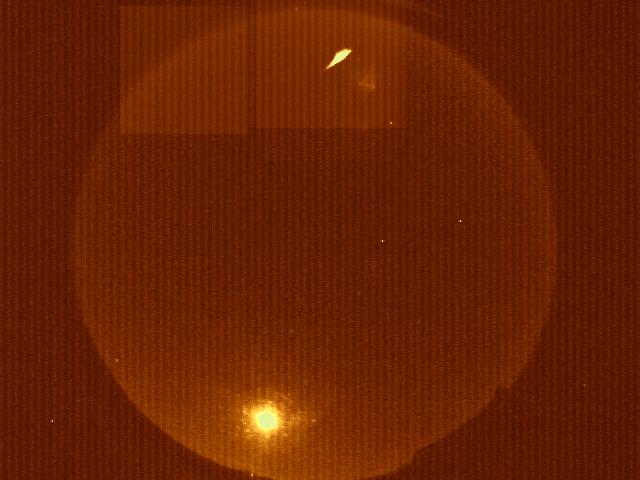
Meteor 3 : April 23, 2008 0823 UT
Observer's Comments : Strong and large fireball. Great stereo sound definition and doppler effect.
Movies:
Movie 1, Sandia National Laboratories Sentinel camera capture, without sound:
v20080423_0823ut_Ashcraft.mov 822 KB 6 seconds
Movie 2, Ashcraft's video and forward scatter system with sound:
Head echo only on first movie.
FB20080423_0823utHE_Ashcraft.mp4 1.3 MB 10 seconds
Movie 3, Ashcraft's video and forward scatter system with sound:
Complete radio reflection. LARGE VIDEO FILE!
FB20080423_0823ut_Ashcraft.mp4 13.2 MB 1 minute 41 seconds
Below: Radio spectrogram of the time of the meteor. 61.250 MHz reception above white line, 83.250 MHz below white line.
Meteor occurs during 0823 and following UT minutes. All other dots and blips on graph are small space dust particles.
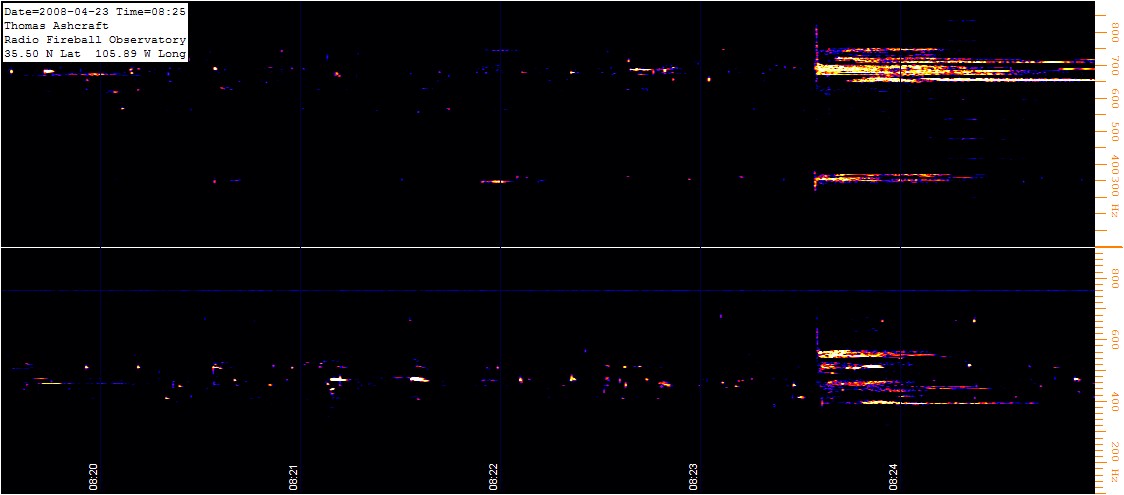
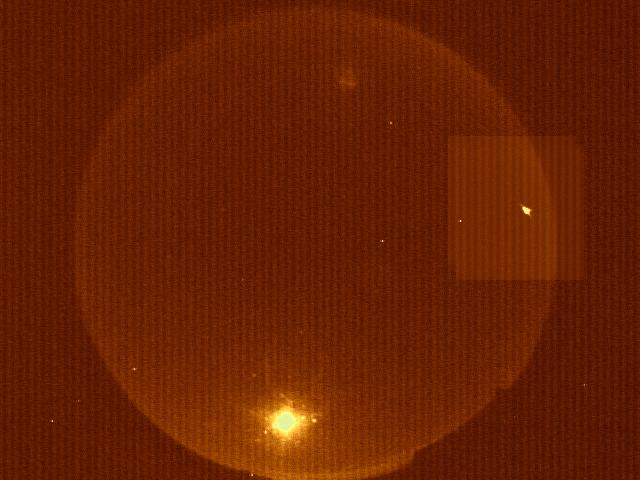
Meteor 4 : April 23, 2008 0849 UT
Observer's Comments : In image above, meteor is small blip in highlighted box area, screen left.
Movies :
Movie 1, Sandia National Laboratories Sentinel camera capture, without sound:
v20080423_0849ut_Ashcraft.mov 817 KB 6 seconds
Movie 2, Ashcraft's video and forward scatter system with sound.
Head echo only for this movie.
FB20080423_0849utHE_Ashcraft.mp4 1.2 MB 9 seconds
Below: Radio spectrogram of the time of the meteor. 61.250 MHz reception above white line, 83.250 MHz below white line.
Meteor occurs during 0849 and following UT minutes. All other dots and blips on graph are small space dust particles.
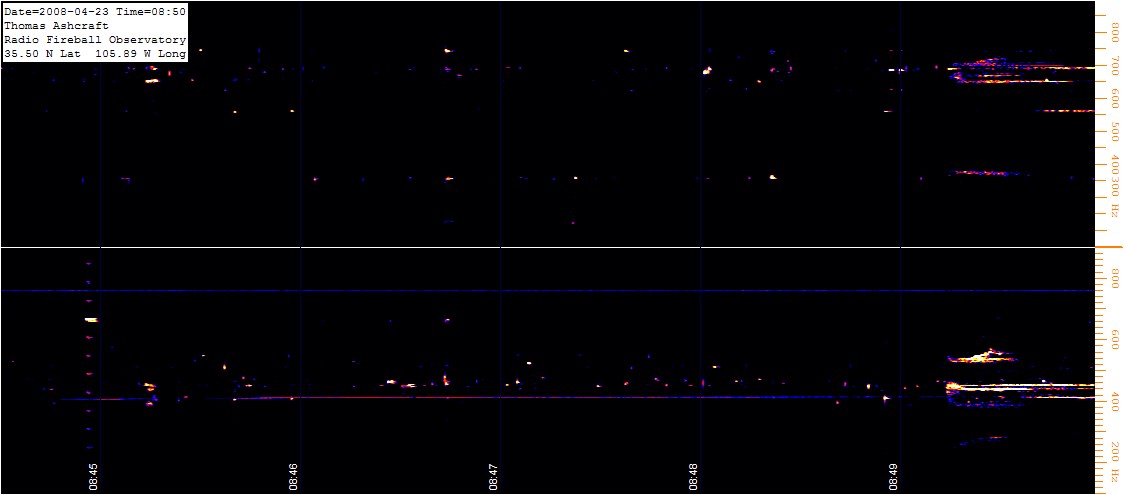
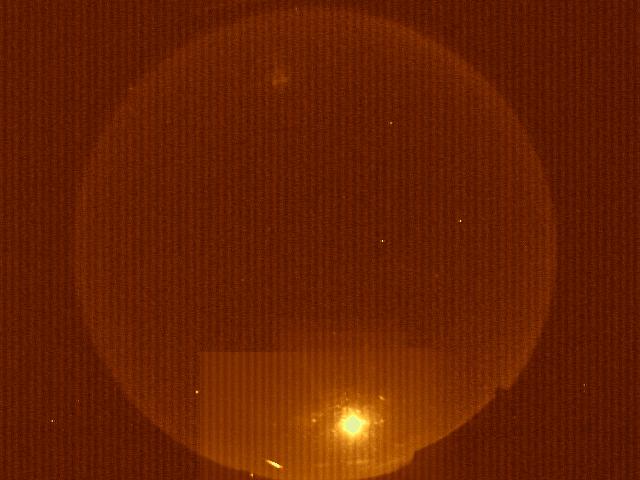
Meteor 5 : April 23, 2008 1017 UT
Observer's Comments :
Movies:
Movie 1, Sandia National Laboratories Sentinel camera capture, without sound:
v20080423_1017ut_Ashcraft.mov 889 KB 6 seconds
Movie 2, Ashcraft's video and forward scatter system with sound:
Head echo only in movie for this long duration radio fireball.
FB20080423_1017utHE_Ashcraft.mp4 1.6 MB 12 seconds
Below: Radio spectrogram of the time of the meteor. 61.250 MHz reception above white line, 83.250 MHz below white line.
Meteor occurs during 1017 and following UT minutes. All other dots and blips on graph are small space dust particles.
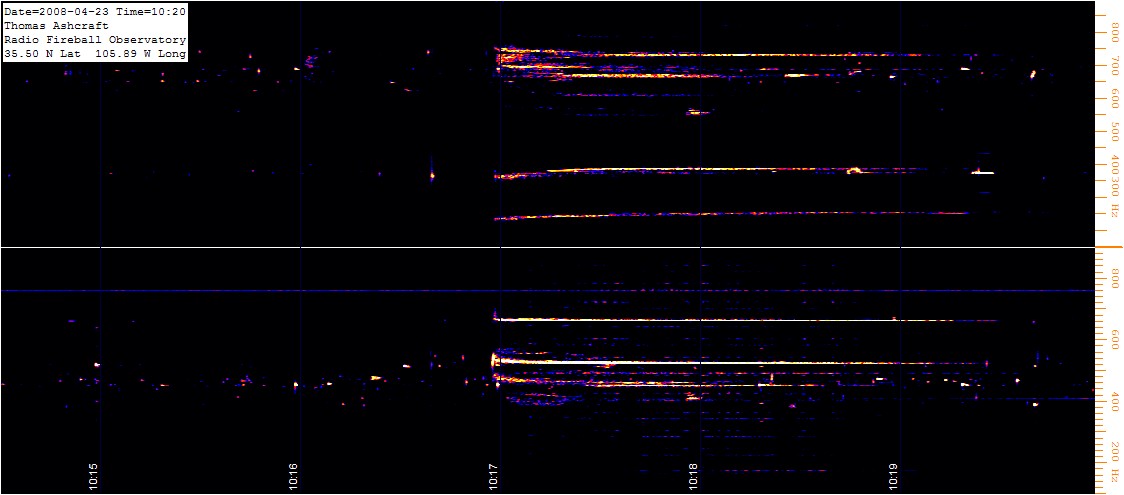
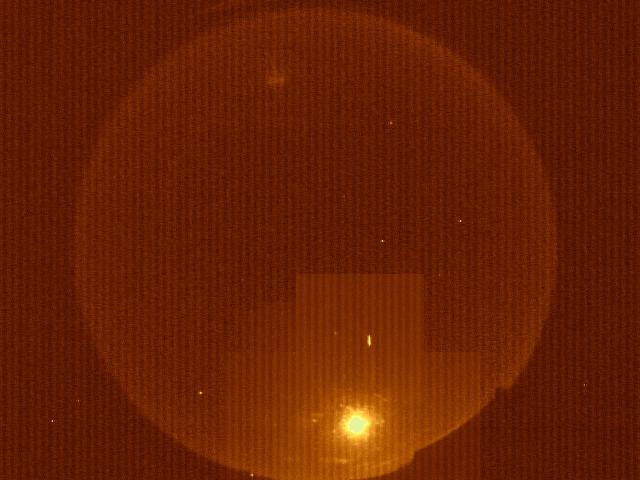
Meteor 6 : April 23, 2008 1021 UT
Observer's Comments : Delayed radio echo. Interesting.
Movies:
Movie 1, Sandia National Laboratories Sentinel camera capture, without sound:
v20080423_1021ut_Ashcraft.mov 870 KB 6 seconds
Movie 2, Ashcraft's video and forward scatter system with sound:
FB20080423_1021ut_Ashcraft.mp4 4.8 MB 40 seconds
Below: Radio spectrogram of the time of the meteor. 61.250 MHz reception above white line, 83.250 MHz below white line.
Meteor occurs during 1021 UT minute. Fireball at 1023 UT was out of visual range. All other dots and blips on graph are small space dust particles.
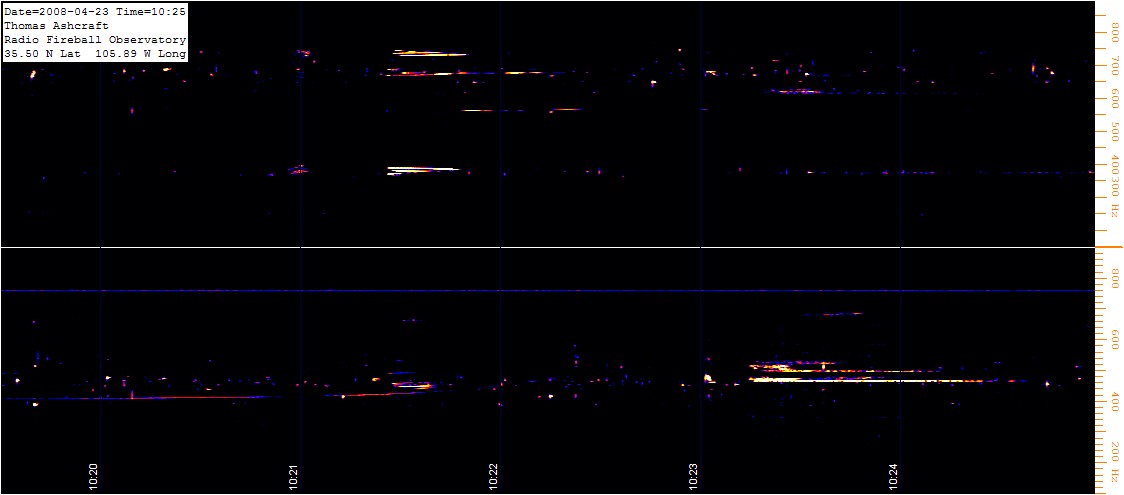
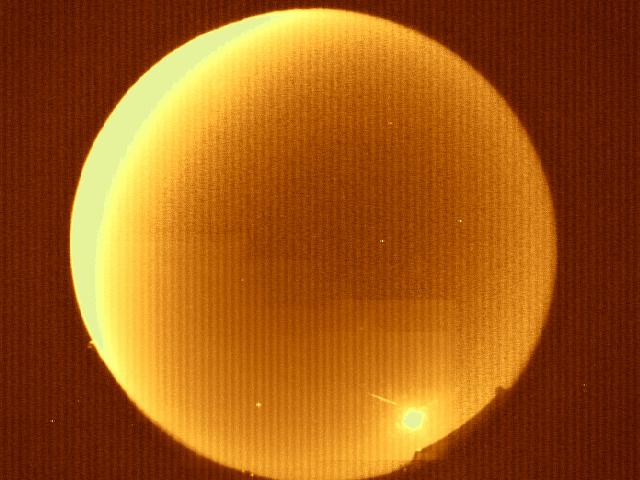
Meteor 7 : April 23, 2008 1136 UT
Observer's Comments : Dawn meteor, streak just at upper left of the Moon.
Movies:
Movie 1, Sandia National Laboratories Sentinel camera capture, without sound:
v20080423_1136ut_Ashcraft.mov 1 MB 6 seconds
Movie 2, Ashcraft's video and forward scatter system with sound:
FB20080423_1136ut_Ashcraft.mp4 4 MB 37 seconds
Below: Radio spectrogram of the time of the meteor. 61.250 MHz reception above white line, 83.250 MHz below white line.
Meteor occurs during 1136 UT minute. All other dots and blips on graph are small space dust particles.
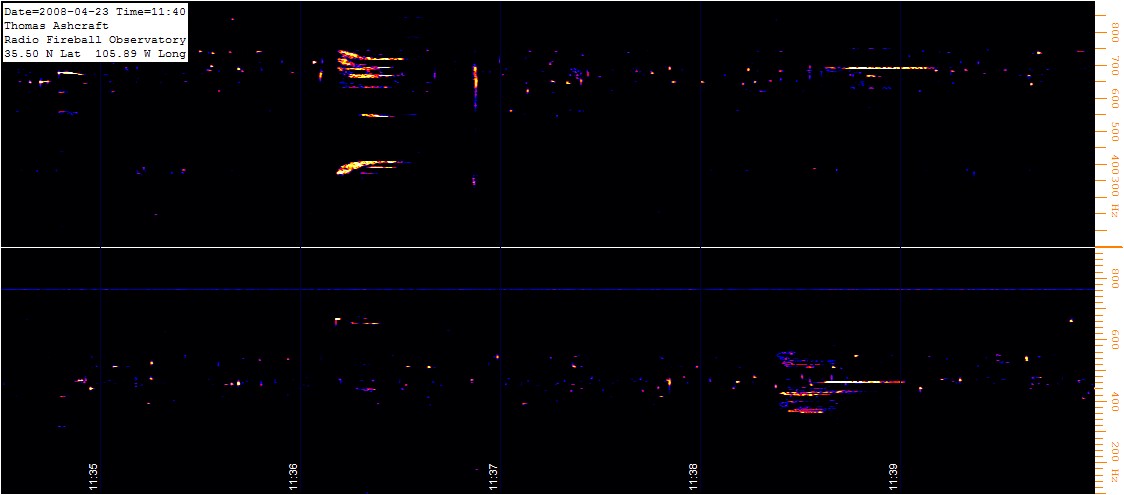
Non-Sentinel Capture - No Image
Meteor 8 : April 23, 2008 0849 UT
Observer's Comments : Sentinel missed this fireball but it was captured on the secondary system with sound.
Movies:
Movie 1, Ashcraft's video and forward scatter system with sound:
Fireball appears at right of screen. Head echo only on this fireball.
FB20080423_0849utHE_Ashcraft.mp4 608 KB 6 seconds
Below: Radio spectrogram of the time of the meteor. 61.250 MHz reception above white line, 83.250 MHz below white line.
Meteor occurs during 0849 UT minute. All other dots and blips on graph are small space dust particles.

Back to Daily
Fireball Archive
Best Selected Fireballs
Thomas Ashcraft
35.50 North Lat. 105.89 West Long.
New Mexico
Mail
To Heliotown and more various specimens
Best Selected Fireballs
Thomas Ashcraft
35.50 North Lat. 105.89 West Long.
New Mexico
To Heliotown and more various specimens